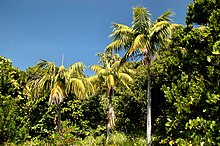
Back خزمة فورستري Arabic خزمه فورسترى ARZ Forstera hoveyası Azerbaijani Howea forsteriana Catalan Howea forsteriana CEB Forstersche Kentia German Kentia palmo Esperanto Howea forsteriana Spanish Forsteri kentiapalm Estonian Howea forsteriana Basque
| Howea forsteriana | |
|---|---|

| |
| Howea forsteriana in habitat | |
| Scientific classification | |
| Kingdom: | Plantae |
| Clade: | Tracheophytes |
| Clade: | Angiosperms |
| Clade: | Monocots |
| Clade: | Commelinids |
| Order: | Arecales |
| Family: | Arecaceae |
| Genus: | Howea |
| Species: | H. forsteriana
|
| Binomial name | |
| Howea forsteriana | |

| |
| H. forsteriana is endemic to Lord Howe Island | |
Howea forsteriana, the Kentia palm, thatch palm or palm court palm, is a species of flowering plant in the palm family, Arecaceae, endemic to Lord Howe Island in Australia. It is also widely grown on Norfolk Island. It is a relatively slow-growing palm, eventually growing up to 10 m (33 ft) tall by 6 m (20 ft) wide. Its fronds can reach 3 m (10 ft) long.[2] The palm gets its common name from the capital of Lord Howe Island, Kentia, and the genus name, Howea, from the island itself. The species name "forsteriana" is after Johann Reinhold Forster and Georg Forster, father and son, who accompanied Captain Cook as naturalists on his second voyage to the Pacific in 1772–1775.[3]
The species is considered vulnerable by the World Conservation Union. It is cultivated on Lord Howe Island by collecting wild seeds and germinating them for export worldwide as an ornamental garden or house plant. The trade in the seeds and seedlings is tightly regulated. This plant has gained the Royal Horticultural Society's Award of Garden Merit.[4][5]
- ^ Johnson, D. (1998). "Howea forsteriana". IUCN Red List of Threatened Species. 1998: e.T38577A10125794. doi:10.2305/IUCN.UK.1998.RLTS.T38577A10125794.en. Retrieved 11 November 2021.
- ^ RHS A-Z encyclopedia of garden plants. United Kingdom: Dorling Kindersley. 2008. p. 1136. ISBN 978-1405332965.
- ^ Frances Saunders (2009-09-11). "H. forsteriana: Kentia Palm". Sustainable Gardening Australia. Retrieved 2017-12-27.
- ^ Cite error: The named reference
RHSPFwas invoked but never defined (see the help page). - ^ "AGM Plants – Ornamental" (PDF). Royal Horticultural Society. July 2017. p. 50. Retrieved 7 March 2018.
